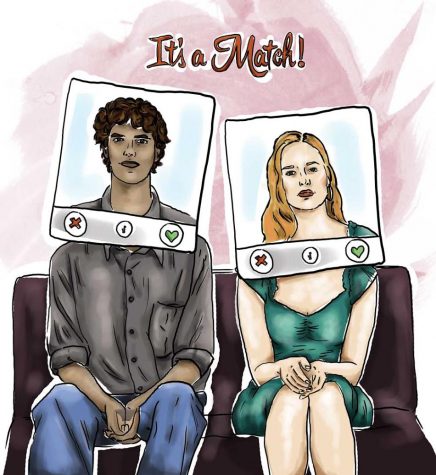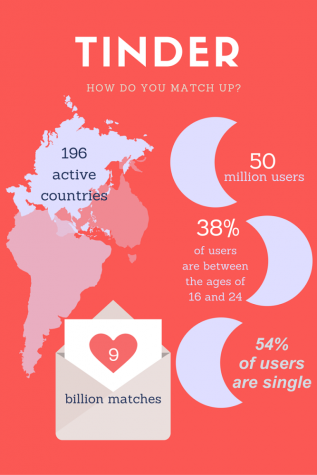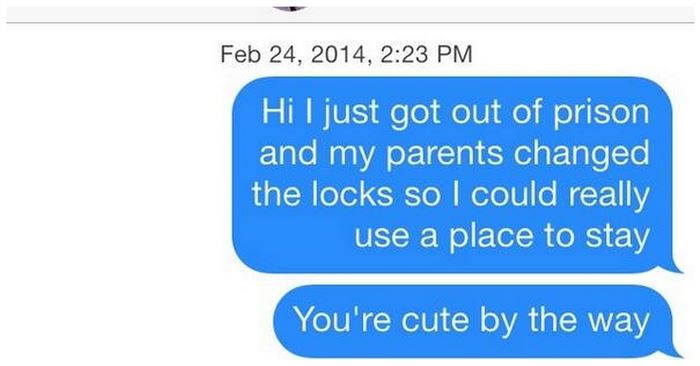Looking for love in all the wrong places
Resorting to the internet isn’t always a walk in the park
February 19, 2016
Solid relationships are dying out faster than something on the endangered species list. It seems nearly impossible to find a significant other who will treat you right. Suddenly, things like getting flowers, going on dates, and being attracted to someone for more than just their appearance are considered “relationship goals,” by literally everyone when in reality, those were only cultural norms just a decade ago.
It feels to many as if there’s no one worth being in a relationship with. Everyone seems shallow and it looks like no one wants to be in a relationship anyways. So what else can you do? The current answer seems to point in the direction of your smartphone.

Relationships starting from Tinder are becoming an increasingly common sight in today’s society.
Enter online dating sites, which, until now, have been associated with old people trying to marry before it’s too late. (Note: It’s never too late.) But then again, no one really uses match.com or eHarmony to find love, anyways. It’s more of a safer version of Craigslist for hookups.
To attract the new generation of yuppies and millennials alike, apps such as Tinder have been created with the intent to simplify and streamline the online dating madness. All you need to do is connect your Tinder account to your Facebook account.
Tinder is primarily for adults, but there’s a separate section for those under 18. That’s where the teenagers are (obviously). Just don’t lie about your age on Facebook, or you can get into some deep, deep… trouble. Think statutory rape lawsuits and possible kidnapping incidents just waiting to happen. So please, stick to the people your own age.
According to the Health Education Content Standards for California Public Schools, code 1.3.G says teachers must “[d]iscuss the characteristics of healthy relationships, dating, committed relationships, and marriage.” However, it says nothing about teaching the different types of dating, including using popular apps such as Tinder. “I teach about relationships in my health class,” says guidance teacher Randy Tiffany. “But I’ve never taught about online dating before to these kids. Maybe I should start.”
The way the app works is fairly simple. You sign up with your Facebook account, then set up a biography or “about me.” Turn on your location services, set up a radius limit, and wait for the candidates to come in. Swipe left if you don’t want to match up with the person, and swipe right if you like them. If the person you swiped right on also swipes right on your picture, then it’s a match.
Based on a compiled report by Expanded Ramblings, Tinder has:
- an estimated 50 million users (as of March 2015)
- 10 million daily active users (as of Sept. 2014)
- been downloaded 100 million times (as of Jan. 2016)
- made 9 billion matches (as of Jan. 2016)
- 1.4 billion daily swipes (as of Jan. 2016)
- 26 million daily matches (as of Jan. 2016)
- 300 matches and 16 thousand swipes per second (as of June 2015)
- 196 active countries
Additionally, 54 percent of users are single, 3 percent are divorcees, and 12 percent are already in a relationship, as of May 2015. The largest age range of Tinder users are 25-34 years old, making up 45 percent of the population; the second largest group is comprised of 16 to 24 year-olds, making up 38 percent.
Marcela Jacobs and CJ McAllister tried it out to see what the hype was all about, and maybe conduct an informal study. And the results they got were pretty interesting, but not all that surprising.
They decided to see which “personality” would attract the most guys, and what types of guys they would attract. Jacobs’ profile was set up to make her look more sexually appealing. McAllister’s profile gave off a more brooding, mysterious vibe. But in both instances, they put their best foot — or their best version of their foot — forward, not revealing anything that would possibly make either of them unappealing. They swiped right on every attractive guy they could find, until they were sure they had milked the app dry.
Jacobs, as expected, got the most matches. She had received so many inappropriate messages, it was insane. When she didn’t reply, she was met with insults and threats from guys who were hurt by her blatant rejection.
McAllister got the second most matches, and offers and requests to meet up. Many of the guys seemed genuinely intrigued by her; the bad boys of her matches (which were most of them) asked to hook up.
“These guys are gross. They’re the like the guys I have to deal with in reality,” Jacobs said. “I don’t think I’d ever take a Tinder relationship seriously. It’s a bunch of BS. There’s definitely a lot of deception going on between people. They lead you on, they only have one thing in mind.”

The statistics of Tinder show that the app generates high traffic and many results.
A Glendale High junior, who wishes to remain anonymous, says he has used Tinder at its bare minimum, and has never learned about it or online dating in general from school. “I simply know the basic functions and just stopped using it,” he says. “It’s just another social media platform geared for teen to young adult interact, whether it be friendly or intimate.
“I personally don’t care if teens do or do not use it; they should be allowed to use the app at their own risk. Unfortunately, I don’t think teens understand the implications of their actions and the potential dangers from social media sites like this, but I support their freedom to [ruin] their life, should they choose.”
“Tinder isn’t the right place to find ‘the one.’ Sure, you’ll find one — a one night stand, that is,” says Jamie Allen, a college student. “If you want to find someone right for you, go to somewhere proper, like a bookstore. Or a coffee shop.”
“This app is like a filtered, slightly less shady version of Craigslist’s casual encounters,” McAllister says. “But it’s also misleading. It’s like a game of catfish. You like what you see, but what you see is not what you get. And that’s what you’re stuck with at the end of the day.”
